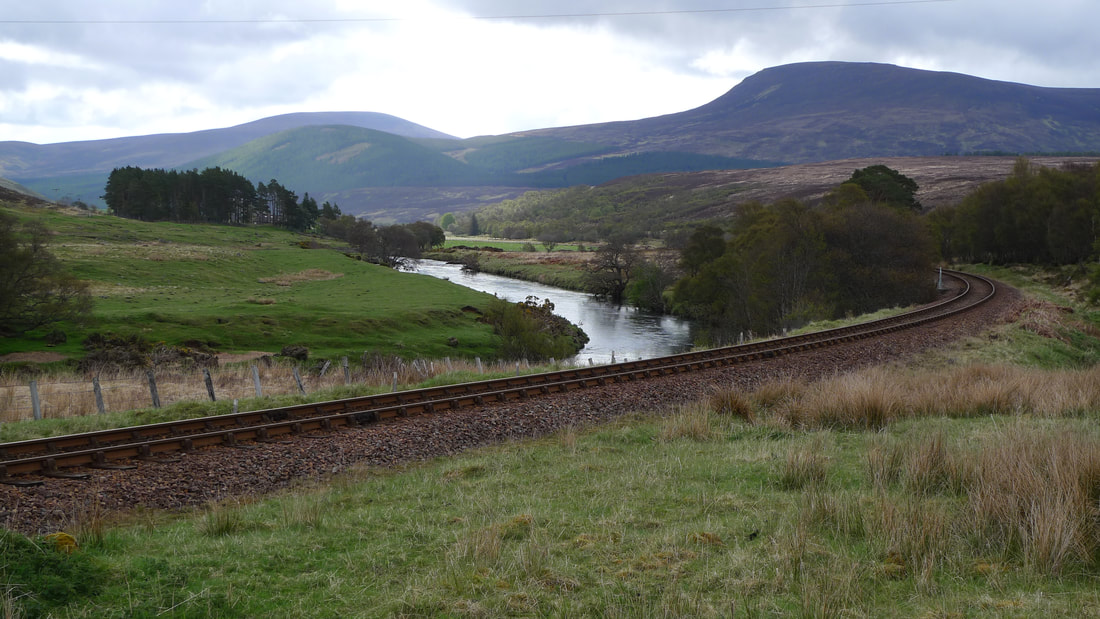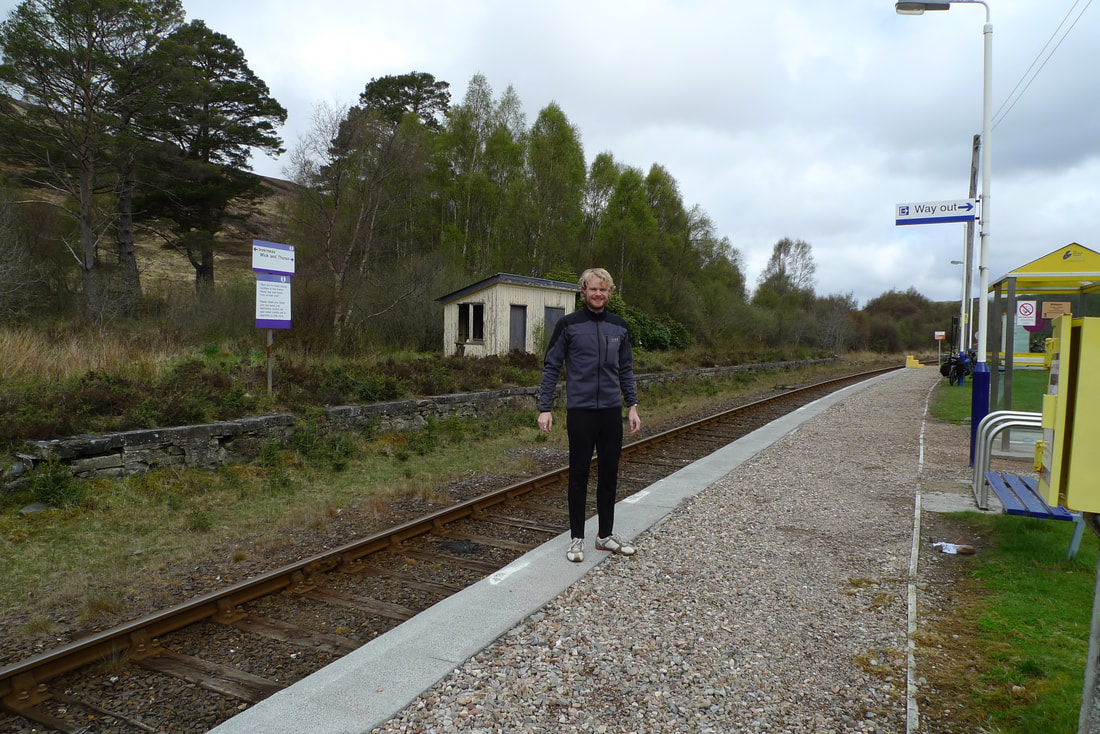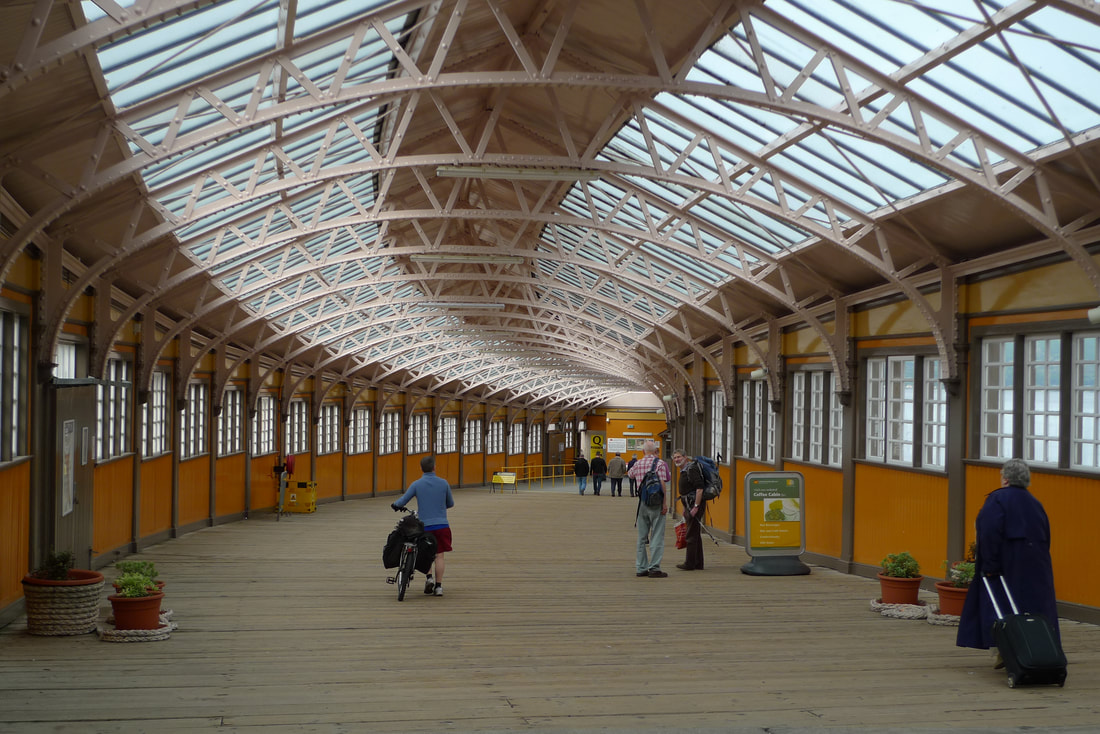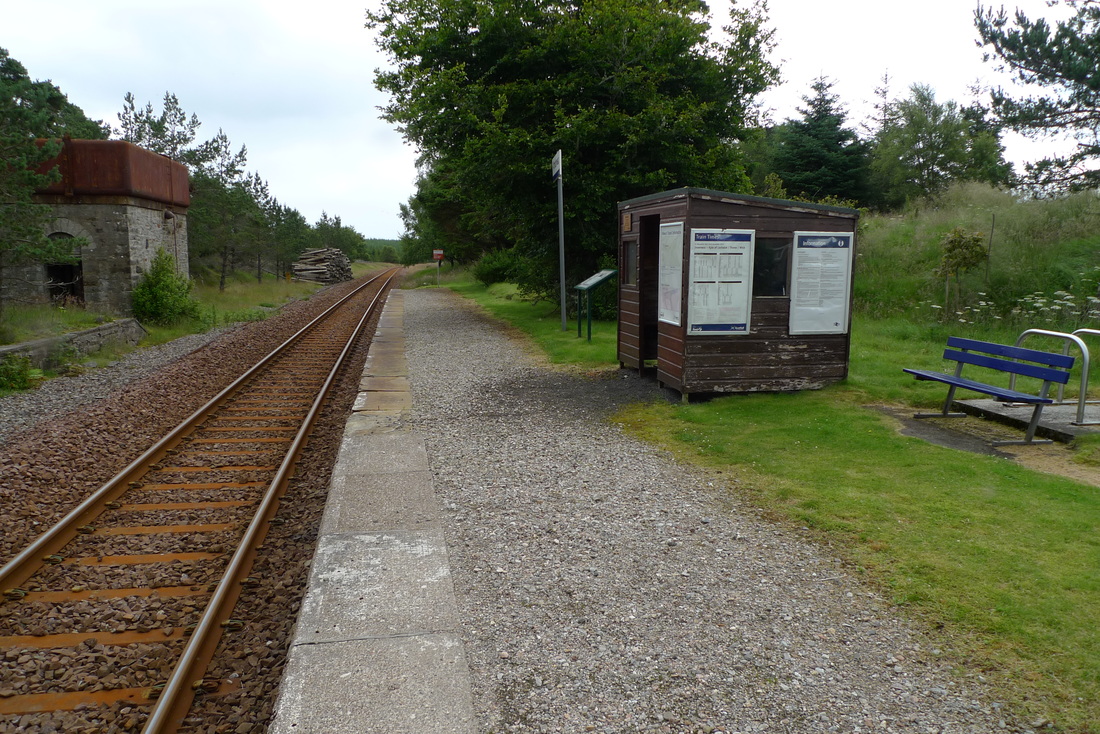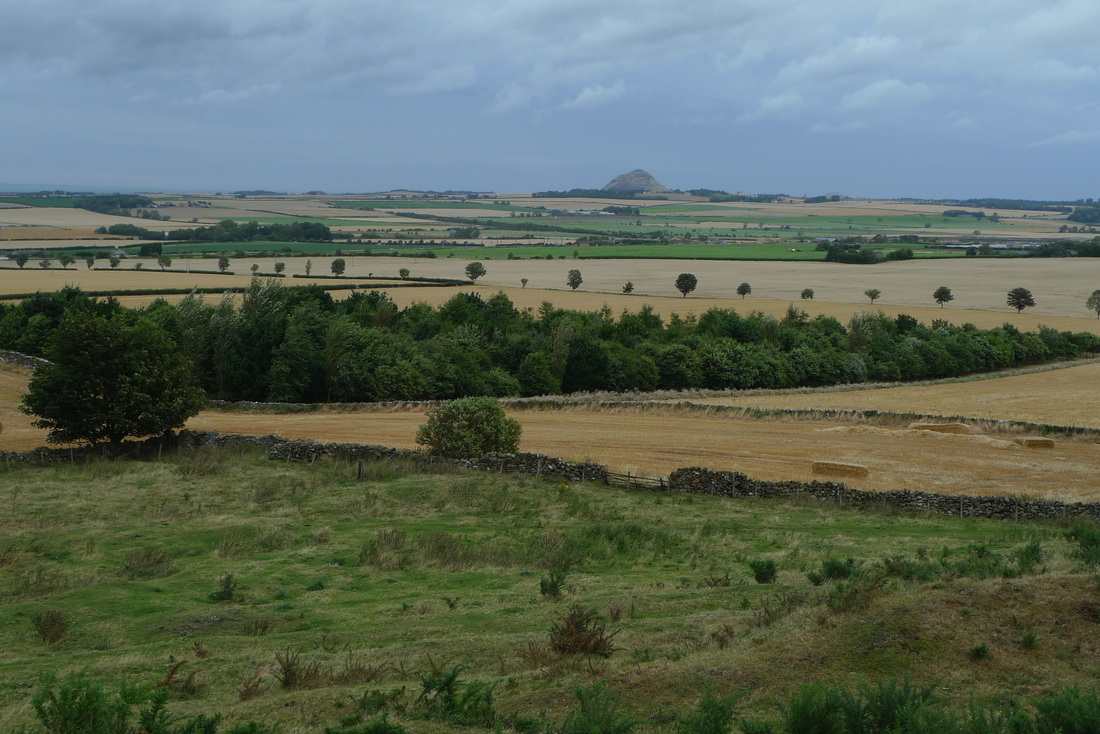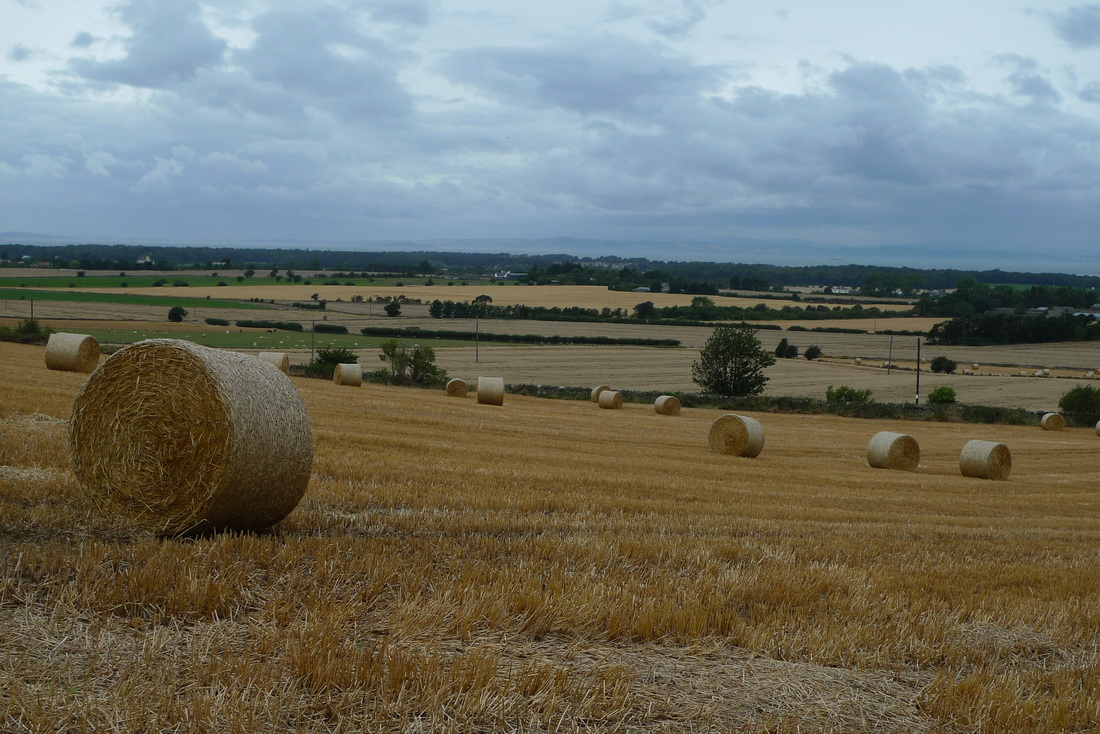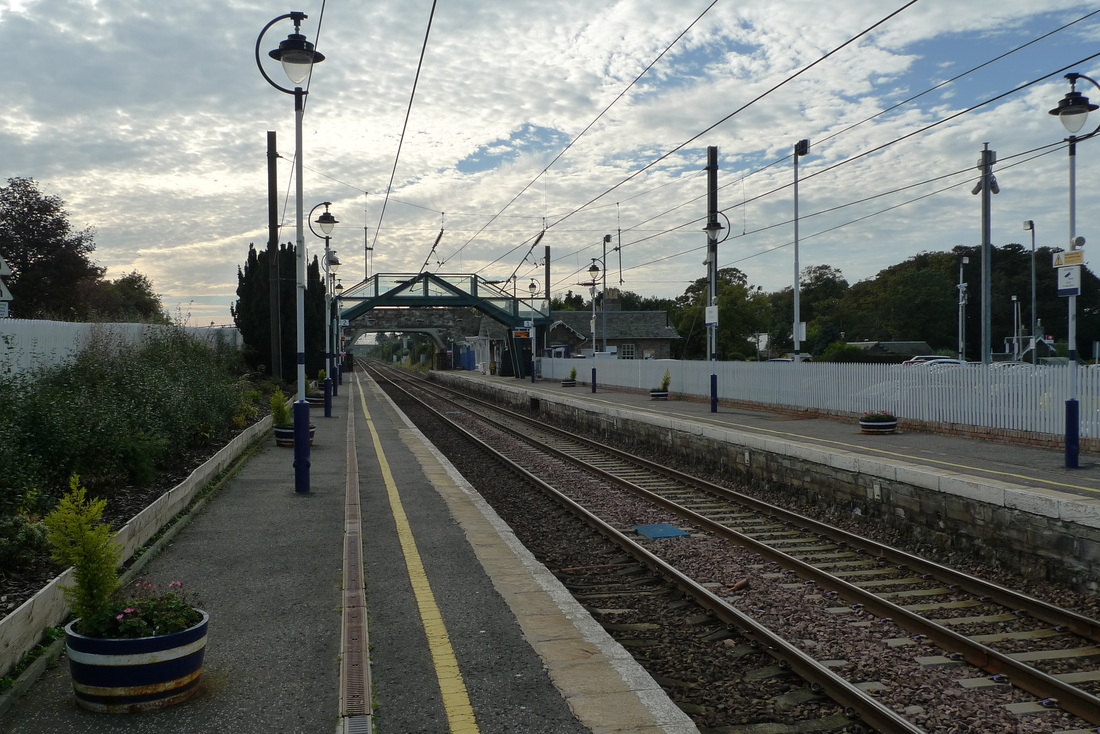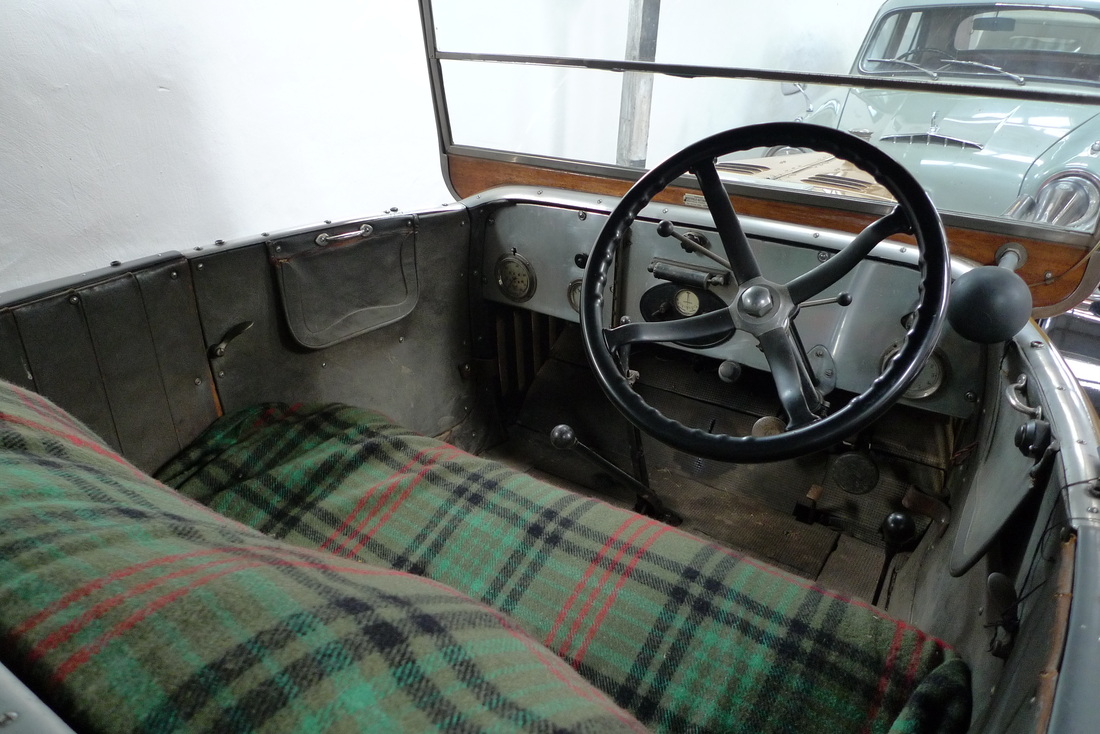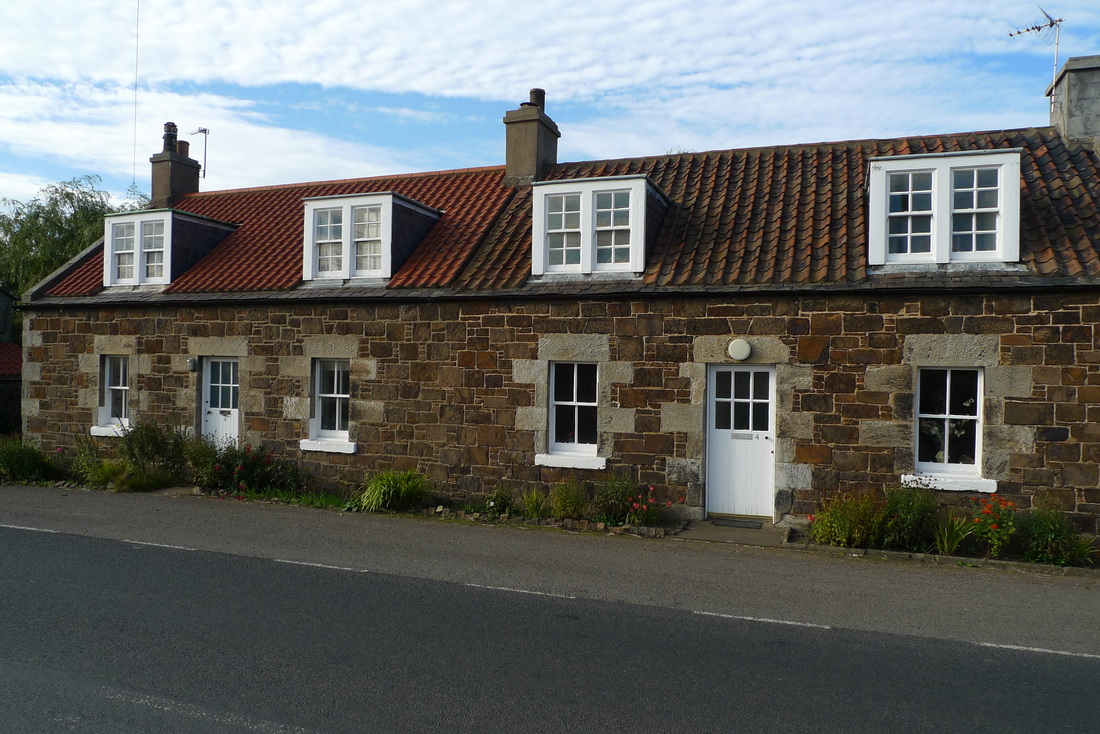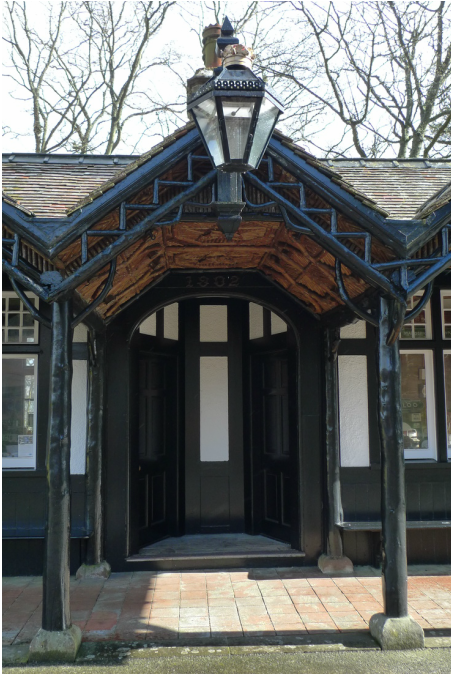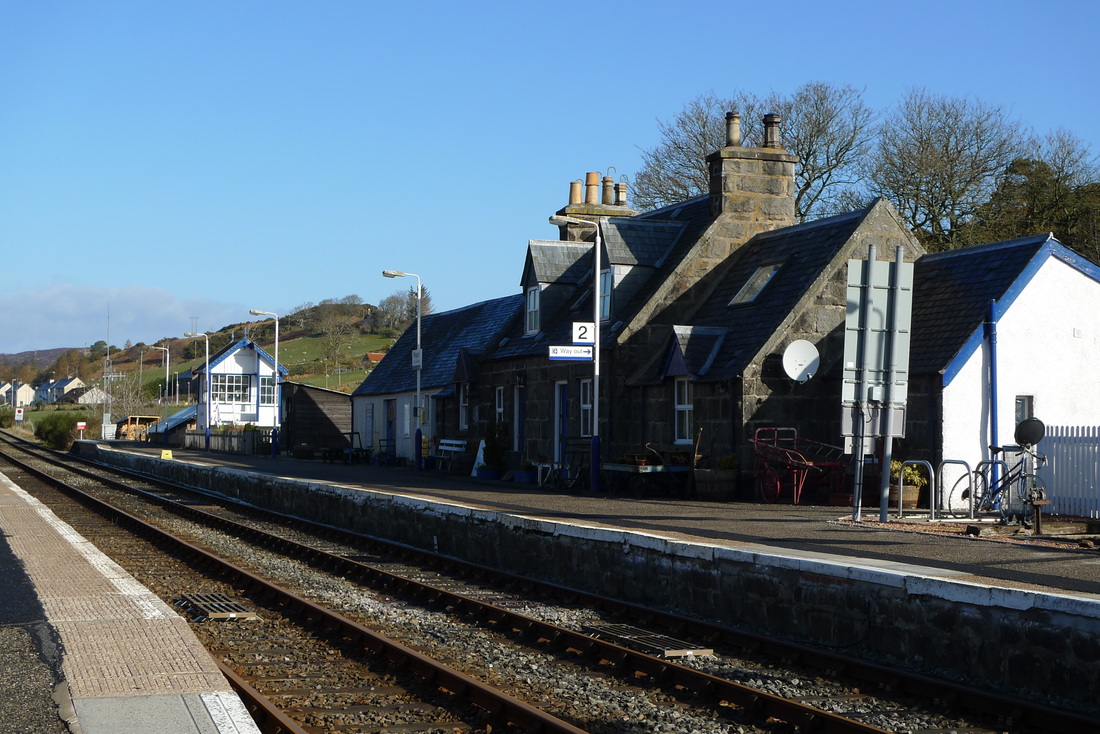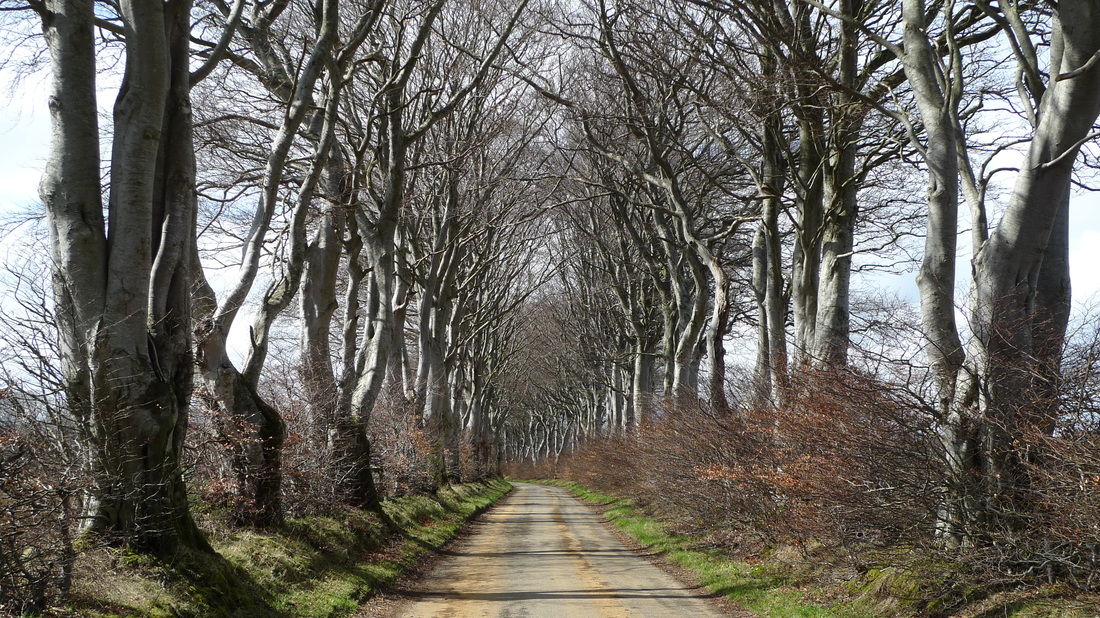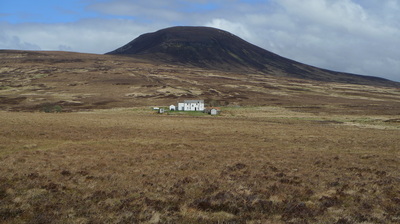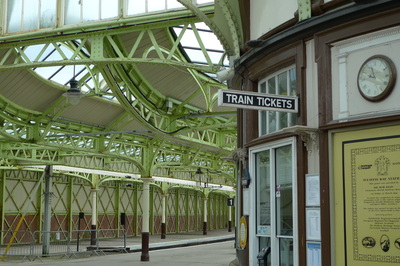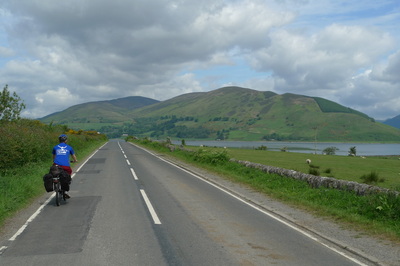Kildonan Station. Come here for peace, beauty and fantastic cycling or just sit for a while18/11/2023
If you need an escape from city life there is a place that is just the ticket. Kildonan is the third least used station in Scotland. This means that you are highly likely to be the only person to get off the train and there is nothing quite like the feeling of having a remote station all to yourself. Give it a try and you will experience a sense of calm mixed with adventure.
A long way
It takes around 7 to 8 hours to travel from Edinburgh to Kildonan, but you will be on some of the most scenic rail lines in the country. Going north for a large amount of time will make you feel like an explorer and just think how many of your fellow passengers will be making as exciting a journey as you? You have to ask for the train to stop at Kildonan Kildonan is a request stop meaning that the train will only stop if a passenger tells the conductor that they wish to get off. Request stops are marked on timetables with an 'x' next to the departure time.
When the conductor comes around to check tickets they will look out for passengers travelling to request stops and take a note to stop the train.
A breathtaking arrival The train follows the North Sea coast where there is a good chance of spotting seals on the beach. After Helmsdale the track heads inland and the final approach to Kildonan curves alongside the River Helmsdale with a backdrop of hills and forest.
Station tour
Let me take you on a tour of the station. It will not take long because there is very little here. And this is precisely what the attraction is. There are no shops, cafes, and loudspeaker announcements. The only sounds are birdsong and the River Helmsdale passing beneath the nearby stone bridge.
The station opened in 1874 and you get the feeling that very little has changed between then and now. The river makes the same sound, it passes the same rocks and the same types of birds are tweeting. I have been to this station twice with a three year gap between visits, but the second time felt like I had just been there yesterday, not years ago.
There is no station building at this location. There is a modern glass shelter, somewhat like a bus shelter. There is a litter bin, timetables and cycle racks.
The disused platform has a wooden shelter on it and this has been left to ruin, which is a shame as it is the only piece of distinctive heritage architecture at Kildonan. The last time I peaked through the window of this shelter I was delighted to find a wood burning stove that looked in good condition. The road to the station
The station is a half-mile detour off the A897. When you think of roads that go to train stations you probably picture traffic and lots of lanes. This is the complete opposite and if you travel down this road it is hard to believe that it will take you to a railway station. This video captures that feeling.
Why come here?
Kildonan station provides access to miles of single-track roads that are superb for cycling. You can read my travel feature about cycling in this area to find out more.
You don't have to bring your bike here. You can simply take a seat and enjoy a few hours of peace and quiet until the next train comes. Whatever you do at Kildonan you will not regret your decision to come here. Read more about Scotland's train stations
1 Comment
I think that this is the most beautiful station in Scotland, perhaps it could even be the most beautiful railway station in the world. There are some buildings that stop you in your tracks. Wemyss Bay is one of them. It is not a station to rush through. Allow plenty of time to slowly take it all in.
Wemyss Bay is on the Firth of Clyde, in West Scotland. It is about 50 minutes by train from Glasgow and if you are heading to the Isle of Bute this is where you come to catch the ferry. The station was built in 1903. The architect was James Miller who had designed about 70 Scottish stations, including Glasgow Central. There was a fascinating array of materials used in its construction, including local sandstone, white pine from the Baltic and Quebec red pine, chosen for its robustness in situations where rot was likely.
The outside of the building has gables and timber framing and looks more Tudor England than West Coast Scotland. It also features a sixty-foot clock tower that is a landmark for the area and can be spotted from miles away. The outside does not prepare you for what it is like inside.
Inside it feels more like a Victorian botanical garden palm house than a station. This is because the roof is a massive glass canopy and the concourse is decked out with colourful flower displays. On a summer's day the light floods through the canopy and it gets you in the mood for your holidays.
The roof is sweeping and curving. The round ticket office is like the base of a fountain with glass and iron erupting from its roof and shooting out in all directions.
Another striking feature of the building is the curving wooden decked promenade to the ferry. It is a regal walkway that makes you feel like you are a king or queen. And yet, Wemyss Bay station was never meant for royalty or aristocracy. It was built to service Glasgow's working class when they took their annual holiday "Doon the Watter". They would crowd into the station to board the ferries across to the Isle of Bute and the seaside town of Rothesay.
The era of flights and cheap package holidays abroad resulted in a downturn in the station's usage, although in recent years it has undergone major refurbishments to keep it looking fabulous. This ensures that it is still a magical experience to arrive here by train to start your island adventure.
Wemyss Bay station has always been famous for the wonderful flower displays on its concourse. Railway companies used to look after station gardens, but this is no longer a responsibility, so for several years the station was flowerless. Thanks to a group called 'The Friends of Wemyss Bay Station' the flowers were brought back and are here to stay. The railway company, Scotrail, has an 'Adopt a Station' programme where funding is provided to local community groups who are interested in looking after the appearance of the station. 'The Friends' also operate a second hand bookshop in the former First Class Waiting Rooms. This shop also has a gallery of photos of the station in the old days.
There is a bar and a cafe inside the station. I have not been to the bar, but the cafe has tables on the concourse, so the ideal place to enjoy the architecture with a coffee. I really recommend doing this, rather than rushing straight for your ferry or train. Why not arrive early so that you can take your time exploring this wonderful station? It is one of Scotland's finest buildings.
I used Wemyss Bay station on my cycling trip to the Isle of Bute. Read my travel feature about this cycling trip
I also used the station when cycling to the Isle of Islay. Read my travel feature about this cycling trip Wemyss Bay is number one on my list of Top 10 Favourite Train Stations in Scotland. Wemyss Bay station is on the front cover of Simon Jenkins' beautiful book Britain's 100 Best Railway Stations. The author has written a glowing entry about this station and the book features several of Scotland's finest stations. You can buy the book from Amazon by clicking on this image: Gleneagles is world famous for its golf course and 5-star hotel. The train station that serves the hotel had been a shadow of its former grandeur for many years. Then came the Ryder Cup in 2014 and investment was ploughed into the station. It is a delight to arrive at this station and it is now one of the finest in Scotland. A stay at Gleneagles evokes the elegance of the 1920s. Back then the wow-factor began as soon as you stepped off the train. Gleneagles station was suitably spectacular, but when the glory days of rail travel passed by and more people took to the roads the station declined. Prior to 2014 I started one of my cycling trips from Gleneagles station. I was saddened to see the train station boarded up. There was still a hint of its former beauty, but it looked neglected and faded. All the windows were boarded up, the doors sealed shut and the paintwork was dull. Sporting events that attract global audiences always bring investment into the local area and this is exactly what happened to Gleneagles station for the 2014 Ryder Cup. A huge number of spectators were expected to arrive by train, so the station had to be up to the job. 3.5 million was spent on lifts, toilets and infrastructure improvements. But the best thing was the reopening of the waiting room, which meant the beautiful bay windows seeing light for the first time in years. Inside the waiting room the walls are wood paneled and there are information boards that tell the story of the area, including the history of the hotel and the railway. The station has also been painted in the colour scheme of the Caledonian Railway, the company that originally built the station in 1919. This reinforces the important heritage of this building. It makes it stand out among other stations in Scotland for not having the Scotrail corporate colours and branding. It is great to see Gleneagles restored to such a high standard after years of neglect. With the hotel and golf course attracting visitors from all over the world I feel proud that they will be seeing this beautiful building at its best. The station is in a supberb location for heading off on cycling trips into the area, so it makes for an enjoyable start to days out in the Perthshire countryside.
Make sure to stop by at Gleneagles station and let me know if you love it as much as I do. I was asked to write a blog for Venture North, the group that promotes tourism in Caithness and Sutherland. This was published on their website in May as part of a collection of blogs from people who are passionate about the area. There is a focus on the undiscovered, the hidden gems of the area, so I decided to write my piece about the joy of railway request stops. There are eight request stops in Caithness and Sutherland. These tiny stations are in remote areas and provide access to superb cycling. It is also somewhat of an adventure using railway request stops- you have to hold out your hand to stop the train. I find them fascinating and I love the solitude and spectacular scenery that they guarantee. Read my piece to find out more. The other blog posts are excellent reads, revealing a great love of Caithness and Sutherland. If you have not yet been to this part of Scotland they are sure to inspire and if you have been before they will give you new ideas of places to visit.
One of the pieces was written by Edwyn Collins, the musician, and one by Lisa Weller, an artist who works from a cottage on the cliffs of Wick. See them all by heading over to Venture North. On a recent trip to Golspie, a village located 50 miles north of Inverness, I discovered that the station house is up for sale. It is a gorgeous building and I wondered what it would be like to live there. I had a look at the estate agent's brochure and discovered that there are many exciting original features. One of my favourite things about the building is this veranda. I can easily imagine sitting and enjoy the fresh air, the sunshine and watching the trains go by.
Another plaque has the initials "SR", standing for Sutherland Railway, the railway belonging to the Duke of Sutherland. You can make this out in this picture, just before the apex of the roof: The house has four bedrooms and inside there are sash and case windows, original fireplaces and some wooden flooring. The most impressive room in the house is the lounge, which used to be separated into the ticket office and station master's office. The fireplace has a Caithness stone hearth. I really like the main window in the lounge which features a cenrtal oval panel. I have never seen a window like this before and it is yet another feature that makes this such a unique home.
There is something very appealing about living in a former train station and the one at Golspie is certainly beautiful. At the time of writing the house is still available, so get in quick if you have always dreamed of such a home. The next station on the railway is Dunrobin Castle, another beautiful station building that I have written about.
This book tells the story of request stop train stations, a quirky feature of Britain's rail network. Dixe Wills travels to 38 of them and explores the areas surrounding the stations. It is an entertaining journey with the author's quirky sense of humour appropriate for the curious history of the stations.
Trains do not automatically stop at request stops and will roll straight through unless a passenger indicates that they want to get on or off. If you are on the platform you must hold out your arm to get the train to stop. If you are on the train you have to tell the guard that you wish to get off. There are over 150 request stops in Britain (equating to 6 per cent of all stations). I have used several request stops during my cycling trips and Dixe Wills also brings his bicycle along on many of his visits to the stations. Like me, he found that having a bike is a great way to explore the quiet roads and rural locations that are often characteristic of request stop stations. He beautifully captures the pleasure of cycling in a summer evening in the chapter about Bootle station in Cumbria: "Cycling through the countryside on a bright cool night is such a joy and such a deeply sensual pleasure that I feel sad for anyone who hasn't experienced it. Noises that get lost in the hubbub of the day sing out across a stage emptied of humdrum rivals. The calls of night-flying birds, the cry of a fox, the sudden squabbling squall of a cat fight, the fearful yelps of lambs and the reasuring responses of their mothers...Smells, scents and aromas rise up out of the ground to launch a sneaky nocturnal assault on your nostrils. On my way up I breathed in newly mown grass, the last of the season's wild garlic...You become more aware of the breeze on your face, the breaths you take in as you take on a climb, the reassuring whir of your rubber on tarmac. It's like being alive, only a great deal more so." The book features five stations in Scotland. I was particularly interested in Dixe's visit to Altnabreac station, one of the best places that I have taken a bike trip. His encounter is somewhat more dramatic than mine when he knocks on the door of a former hotel and has a bizzare encounter with the owner. This was my favourite part of the book, a real page turner, and I will not spoil it for you by saying anything more about it. In fact, Dixe has many adventures during his railway journeys which adds plenty of drama to the book. Some people may not enjoy the author's sense of humour and very personal touch, but it had me smiling and I identified with his happy-go-lucky approach to travelling. For example, he admits to always underestimating how much time is required to get to a place and having to run very fast to avoid missing trains and this is the main means by which he keeps fit and gets exercise. I previously reviewed another of Dixe Wills' books- Tiny Islands. It is a very different book to Tiny Stations in terms of the layout with maps and beautiful photography, but a similar "tiny" theme. Tiny Islands is much more of a practical travel guide and you can use this to plan journeys to the islands, whereas Tiny Stations is more of a travel novel and if you want to follow the journeys you will need to do your own planning. Both books are inspiring and you will want to make your own trips to the tiny islands and tiny stations of Britain after reading them. Many cities in Europe have cycle hire schemes, the type where you put a credit card into a machine and then take a bicycle. Earlier in 2015 there were newspaper stories about the possibility of such a scheme coming to Edinburgh. Glasgow already has a scheme with 400 bicycles across 31 hire stations. Abellio, the new operator of Scotrail, announced that they would introduce cycle hire at train stations. Drem station in East Lothian would make an ideal candidate for a cycle hire facility and this is why... Although the station is in a rural area it is only 25 minutes from Edinburgh and provides easy access to many visitor attractions within short cycling distances. The roads are light on traffic and largely flat, so it is ideal for people new to cycling. The station could easily become a leisure cycling destination with daytrippers travelling from Edinburgh, perhaps it might even be possible to offer a combined rail and cycle hire ticket and even discounted entry to some of the visitor attractions. I have blogged about the variety of interesting things to see and do from Drem station. Here are five that can be visited on short cycle trips from the station: Visit Concorde at the National Museum of Flight- 3.8 miles from Drem station Climb to the top of an iron age hill fort- Chesters hill fort is a little over a mile from Drem station Climb to the top of a tower for stunning views over the countryside towards the sea- the Hopetoun Monument is a little under 3 miles from Drem station Do you agree that Drem would be a good place to have a cycle hire scheme? Are there any other train stations that you think should have cycle hire available?
I have been blogging about the interesting things to see and do from Drem station. Within very short cycling distances of the station there is an amazing variety of places to ride to, from the birthplace of Scotland's flag to the cockpit of Concorde. This blog visits Chesters Hill Fort. From Edinburgh Waverly station the train takes 25 minutes to reach Drem, located in East Lothian. The station is the prettiest on this line that travels as far as the seaside town of North Berwick. The stone cottage-style station house is now a private residence from where you can buy free range eggs. Chesters Hill Fort is a 10-minute cycle from the station. If you are expecting some sort of wooden fortress protecting a village of huts with smoking fires then you will be disappointed. The large mound of grass that formed the ramparts is all that remains, but there is an information panel that will help you to picture what this place was like 2000 years ago. This visit is as much about walking as it is cycling. To get an impression of how big the fort was, and it is quite an extensive site, it is worth walking up the ramparts. You may have to dodge past some curious cows during your walk- this is farming country after all. From the top you will have an extensive view of all that luscious agricultural land and all the way to the sea. It is mainly flat apart from one obvious chunk of hill in the far distance. This is North Berwick Law, which also had an Iron-Age hill fort. If you take the train (or cycle) to the next station on the line, North Berwick, you can hike up the hill for some of the best views in East Lothian. Chesters has not been excavated so there is not very much known about the site. In the Second World War it was used as an observation post for the airfield at RAF Drem. To reach Chesters Hill Fort take a left out of Drem station onto the B1377. Then take the first left and follow this road until you reach the turnoff for the fort. The turnoff is a steep road and during my visit the fields were full of huge bails of hay. The the rest of the route is fairly easy on the leg muscles. It will only take about 10 minutes to cycle there. You will have time to fit in one or more of the other cycle trips that can be done from Drem station: The National Museum of Flight to visit Concorde Myreton Motor Museum Athelstaneford, the birthplace of Scotland's flag My previous blog post described a cycling journey from Drem station to the National Museum of Flight. Another trip you can do from Drem is the 2 miles to Myreton Motor Museum. Drem Station This station is just 25 minutes from Edinburgh and is located within the fertile lands of East Lothian. The station has a stone cottage, picket fence and flower pots. This view of the platform shows the lamp posts that I think look like a modern reinterpretation of the type of lamps that that might have been in use when steam locomotives still plied this line. To reach Myreton Motor Museum turn left on leaving the station, onto the B1377. Then take the first right which goes under the railway. This road is typical of the quiet hedge-lined routes in East Lothian. Within ten minutes you will reach the white building of the motor museum. It is not a big museum and if you are not very interested in motor vehicles you might find that half an hour is enough time. But if you are fascinated by this sort of thing you will want to read every information panel and admire all of the vehicles from every angle. There are certainly some beautiful cars on display. Some of the cars have fascinating histories. For example, the 1925 Morris Oxford in the picture below. This was bought from a scrap yard by Willie Dale in 1952. He took the car home to give it a good clean and then discovered an unopened letter down the side of the seats. It turned out that the letter had been written by his aunt and the car had been owned by his grandfather when it was new! A close up of the seats in the Morris Oxford: There are some bicycles on display at the museum. They have handwritten notes giving their history: Amongst the sports cars and glamorous classic there are some unexpected vehicles, such as this Hilman Husky. I enjoyed this little museum, but it doesn't take long to see all the exhibits, so you might want to combine it with one of the other nearby attractions. There is plenty more that you can cycle to from Drem station. Why not try the National Museum of flight where you can see Concorde?
Myreton Motor Museum has an entry charge, which is currently £7 for adults (March 2015).
Take a train to Drem, only 25 minutes from Edinburgh, and you will be spoilt for choice for cycling destinations. It has to be one of the best placed train stations for the number of interesting things that are easily cycled to. Top of the list is Concorde at the Museum of Flight , but there is also a motor museum and the birthplace of Scotland's national flag.
Drem Station Drem station is located within the farming landscapes of East Lothian. If you come here as a foot passenger you will find it more challenging to travel to the places I mention here. There are bus services, but a bicycle makes it easier and because the distances are short and there are few hills you don't need to be super fit to enjoy this.
I think that Drem is the prettiest of all the stations along this line. It has a stone cottage that is now a private home. You can buy free range eggs here and during one visit the owners were trying to sell a mangle.
National Museum of Flight
On leaving the station turn right and follow the B1377. The museum is well sign-posted. The road is flat, fairly quiet and it is 3.8 miles to the museum. This is farming country so you will see fields of enticing produce:
You will also see some of the typical East Lothian rows of cottages:
At the Museum of Flight you can board Concorde and visit the passenger cabin and view the cockpit.
"I'm still impressed to think of all those people having their roast beef and champagne behind you while you're cruising at a speed slightly faster than a rifle bullet." Brian Tubshaw, Concorde test pilot.
Concorde could travel from London to New York in 3.5 hours. It took 4 hours longer to travel on a normal airliner. There was and still is no faster way to travel by plane. The Concorde experience was exclusive to the rich and famous and a ticket was beyond the average person, so being able to see the inside of this aircraft is quite a special experience. Whereas most of us could only dream of flying in this aircraft once in a lifetime, some people could afford to use it as standard transportation. Rod Stewart once flew over his stylist to America to sort out a haircut that went wrong and one wealthy New York socialite paid £2,500 to fly over a favourite box of Mayfair chocolates so that she could have them at a party. Concorde's last flight was in 2003, but the aircraft still looks like something from the future. It is incredible that something that could fly this fast will never take off again and that there is nothing to replace it, but there were several factors that led to its retirement- a Concorde had crashed in 2000, there was a general slump in the aviation industry and maintenance costs were huge. The museum tells the story of this remarkable aircraft with displays and memorabilia, but there is a lot more to the Museum of Flight than Concorde. The site is huge and there are several hangers full of aircraft.
You could easily spend a day at the museum, so there might not be time to cycle to the other attractions near Drem station. Why not return to Drem station again and do one of the other cycle trips that begin at the station?
Part two of this blog will cover the cycle from Drem station to Myreton Motor Museum. National Museum of Flight is located in East Fortune. It has an entry charge and a café. Edinburgh has two mainline train stations. The more famous Edinburgh Waverley where the majority of visitors to the city get on and off trains. Then there is the lesser-known Haymarket which is more convenient for the west of the city. It recently had a £25 million redevelopment which I think is worth celebrating.
The journey time between Haymarket and Waverley is only four minutes, so I used to wonder what the benefit was in having two stations in the city. That was before I lived in Edinburgh and now that this is my home I find that Haymarket was my best option for catching a train. For several years my flat was a ten minute walk, or 5 minute cycle, from Haymarket so it was very convenient for starting out on my trips. It meant avoiding the busy roads that I would have to take if Waverley was the only train station. The main disadvantage of Haymarket, for a cyclist, used to be the lack of lifts to the platforms. Carrying my bike, fully loaded with panniers for a weekend trip, down those stairs was a real test of strength. Some lifts were eventually installed, but they did not serve all of the platforms. Inevitably, when returning home and feeling tired after lots of cycling and a long train journey I always seemed to arrive at one of the platforms with no lift. I would summons up my reserves of energy and haul my bike up the steps. I always thought that it must be worse for visitors to the city who do not know this and arrive with their bicycle, or luggage, at Haymarket pacing up and down the platform looking for a lift that does not exist. That all changed with the redevelopment of Haymarket. There are now lifts to all platforms and the station has a spacious modern look. The main concourse almost feels too big as it never fills up with people, but this is because the station has been built with future growth in mind. Passenger numbers are expected to climb from the current four million a year to 10 million by 2030. It feels a little soulless and lacking in the atmosphere and excitement that you get at Waverley station. There is a coffee kiosk in one corner and a Marks and Spencer food outlet, but I feel that they could have made more out of the original 1842 station building. It has wonderful tall windows on the upper floors and this could have been a great location for a cafe with views of both the concourse and the street, perhaps a grand cafe that stations of the steam age would have had. But, I am a romantic when it comes to such things. The main thing is that Haymarket is a station for the 21st century that services the demands of the modern railway passenger, including those with bicycles.
This is Dunrobin Castle station. Ever since I found out that a castle has its own train station I wanted to make the journey here. I loved the idea of getting on a train at Edinburgh and travelling about six hours to the North Highlands to this station and then walking into the grounds of Dunrobin Castle.
Dunrobin Castle is the seat of the Duke of Sutherland and the family had this private station built. The station dates from 1902 and is in English Arts and Crafts style, an unusual choice of architecture for Scotland.
Anybody can get on or off at this station, but trains only service it during the summer season between April and October. It is also a request stop meaning that you must hold out your hand, as if stopping a bus, when the train approaches. If you are on the train you must tell the guard that you wish to get off. Opposite the station, across the main road, is the entrance driveway to the castle. It is about a five minute walk.
The station interior is now a museum crammed full of railway memorabilia. There are no set opening hours of the museum, but you can check at the castle when it is next open. If it is not open when you are there you can look through the windows and see the treasures inside.
The station was closed in 1965 as part of the Beeching cuts to Britain’s Railways. However, the station's value to tourism and encouraging visitors to Dunrobin Castle became obvious and in 1985 it opened on summer Sundays. By 1994 it ended up back on the timetable with a regular service.
The station got its 15 minutes of fame when it featured on the television series Great British Railway Journeys. The presenter Michael Portillo cut the ribbon to the station's newly refurbished toilet. The toilet had been derelict for years, but has now been restored with modern fittings in an Edwardian style, including a high level cistern. There is a plaque inside the cloakroom that marks the occasion.
My previous blog post was my top ten favourite train stations in Scotland. You might be wondering why on earth Dunrobin Castle station did not make this list.
For a cyclist it is not the most practical station because of the low platform. I had actually bought an advanced ticket to leave from Dunrobin with my bike, but when I saw the big yellow plastic step that I would have to use to haul my bike up to the train I changed my mind. I decided instead to board the train at Golspie station which is only 2 miles away and has a platform level with the train. The station only gives access to the busy A9 road which is not the most pleasant to cycle on, but you can access some quieter roads leading off from the A9. However, if you want to visit Dunrobin Castle and are on foot then taking the train to the castle's own station is a must. Even if you don't take the train to Dunrobin Castle allow some time to walk up the driveway and cross the road to have a look at this unique station building. 10. Montrose Montrose is the least memorable station building on the list, but the location is pretty special. If you are travelling from the south make sure you are on the left side of the train so that you witness the approach alongside Montrose Basin. You cross an impressive stone viaduct with little boats moored below you. Then you cross a wrought iron lattice viaduct. There is a chance of catching a glimpse of one of the many bird species that live here, including 60,000 migrating geese. On the platform you can look out on the water and use the information panel to identify the birds. In terms of cycling routes there is a marked cycle path to the Montrose Basin visitor centre where you can find out more about the birds. From there you can cycle all the way around the Basin, but the road is mostly away from the shore. You can stop off at the House of Dunn, an 18th century country house where there is a cafe, gardens and tours of the house. At Bridge of Dunn you can take a steam train on the Caledonian Railway to Brechin (limited operation, check their website). If you have time to cycle further you could make it to the pretty town of Edzell with its ruined castle that has peacocks strolling the grounds. Montrose is located 40 to 50 minutes by train from Aberdeen 9. Rannoch Remote and inaccessible stations are to be found all over Scotland. Rannoch is the ultimate in cut-off stations.The station is surrounded by Rannoch Moor which is 50 square miles of bog. There is no road access to Rannoch station from the A82 Fort William road- the only way in is via Pitlochry and this is 40 miles on a minor road. Remarkably the station has a tea room that operates in the summer months and there is even a hotel for the ultimate wilderness stay. The main reason to bring your bike here is to cycle around Loch Rannoch The road around the loch is flat and there is not much in the way of traffic. It is a 32 mile round trip from the station. You will have to cycle fast to be able to do this route between trains as there are very few trains. Or you could cycle the 40 miles to Pitlochry where there is a station with trains to Inverness or south to Glasgow and Edinburgh. I once got stranded at Rannoch because I missed a train. You can read my blog post: Stranded at Loch Rannoch Rannoch is 2 hours, 50 minutes by train from Glasgow 8. Gleneagles The world famous hotel and golf course are still the epitome of elegance and luxury, but Gleneagles station is somewhat faded. The buildings are boarded up, but the iron canopies and sweeping stairs still whisk your imagination back to that era of straw boaters and flapper dresses. The good news is that Gleneagles will be receiving a major facelift in time for the 2014 Ryder Cup. The passenger waiting rooms and toilets will be restored and everything will be painted in burgundy and cream, the colours of Caledonian Railways. I really think that a tea room would be a great addition to Gleneagles. There are plenty of unused station buildings with attractive bay windows that would make for a very pleasant cafe. There is a great cycling route from the station into the Ochill hills and a chance to see the spooky Dunning witch memorial and the longest high street in Scotland located in Auchterarder. Read about this cycling route from Gleneagles station. If you are staying at Gleneagles Hotel they will collect you from the station in a chauffeur driven car. Read about my stay at Gleneagles Hotel. Gleneagles is around 1 hour and 25 minutes from Edinburgh 7. Dalmally Dalmally station has a red sandstone building, glass canopy and a fountain with a granite heron. It once housed the "Duke's Room" for the exclusive use of the Duke of Argyll to wait for his train. For years the station was boarded up and a faded reminder of the once great days of the the railway. However, the building now has new owners who are restoring it, including the "Duke's Room". They have a craft studio inside the station that can be visited. Hanging baskets and flower tubs now adorn the platform and the granite heron has been polished to a shine. Just two miles of cycling takes you to Kilchurn Castle, one of the most photographed castles in Scotland. Loch Awe is also nearby and a road circles it, making for excellent cycling. There is hardly any traffic, although there are some steep hills on the west shore. You could cycle on past Loch Awe to reach Kilmartin which has more than 800 ancient monuments, including standing stones, burial cairns and the remains of a fortress. Read about my cycling trip around Loch Awe Dalmally is 2 hours, 20 minutes by train from Glasgow 6. Rogart Rogart is a "request stop" meaning that the train will not stop here unless a passenger specifically requests to get on or off. If you are on the platform this means holding your hand out as the train approaches, as if thumbing a ride. If you are on the train this means telling the guard in plenty of time that you wish to get off. Rogart is worth requesting because there is a nice surprise behind the station cottage. A collection of old railway carriages that have been converted into accommodation. You can stay the night in a first class compartment or even a 1930s showman's wagon. As for cycling, there is the wonderful Strath Brora road. There is nothing here, but moors, rivers, lochs, waterfalls, sheep and peacefulness by the bucket load. You could visit Dunrobin Castle which looks like it comes straight from a fairytale. Nearby is Carn Liath, an Iron Age Broch, but this does involve some cycling on the busy A9. Rogart is around 2 hours by train from Inverness 5. Insch Can a station bring a smile to your face? Insch does it for me. I fell in love with this tiny little station cottage as soon as I got off the train. Inside the waiting room the only sound is the baying sheep from the field next to platform two. From the station it is a short cycle to one of my favourite roads in Scotland, lined with beech trees. The trees are sturdy and tall and make you feel that you are travelling in nature's tunnel. The road leads to a Pictish standing stone, The Picardy Stone. You can also hike up a hill to the ruins of Dunideer Castle. Read about my cycling trip from Insch station Insch is around 35 minutes from Aberdeen 4. Pitlochry Pitlochry train station is pristine with pretty flower arrangements. It was built in 1883 in Scottish Tudor style and has many original features like the terracotta roof, tall chimneys and thistle shaped finials. Inside there is a a bookshop so that you can browse and find something to read on the train. Pitlochry is one of the best places in all of Scotland to set off on cycling trips. There are so many options for day trips that you could easily spend a week here. Nearby is Loch Faskally and Loch Tummel where there is a steep climb to the Queen's View which is one of the most famous panoramas in Scotland. You could head to Blair Atholl to see Blair Castle and stop off at the Pass of Killiecrankie with its dramatic gorge. You could link up with one of the other stations on this list- Rannoch- with a 40 mile ride. If you are searching for a long distance trip then you can cycle all the way to Inverness on National Cycle Route 7. For ideas of things to see and do in Pitlochry check out this blog Pitlochry is about 1 hour, 45 minutes by train from Edinburgh 3. Kildonan Now we come to a place where you really feel that you have landed in a vast area of wilderness. When you get off the train at Kildonan don't rush to get on your bike and start cycling. Wait until the train has gone and then listen to the sounds. The trickling burn and a few songbirds is pretty much it. There is no station cottage here, so the architectural merit of Kildonan is limited to a glass shelter that looks more like a city bus stop. But you don't come to Kildonan for that. You come for the wilderness and excitement of the location. Look across to the hills and you might just see some red deer. This is the ideal place to begin a cycle tour of Scotland's Far North. Come well prepared as it will be a long time before you come across a shop. Head for the intriguingly named village of Bettyhill. On the way you will pass the remotest hotel in Britain, The Garvault Hotel, where you will likely be the only person stopping for a cup of tea. Kildonan is around 2 hours, 45 minutes from Inverness on the train 2. Altnabreac Another station in the middle of wild country, Altnabreac is one of the least used stations in Scotland. The reason is that there is nothing here. Everyone should feel what it is like to be the only person to get off a train and be totally alone. You are pretty much guaranteed of that experience at Altnabreac. There is only one road out of Altnabreac and it is bumpy with lots of potholes, but you will be the only person using it. Enjoy having all of this space to yourself. The landscape is quite barren. There is a loch with a small beach where the only sound is the trickle of the water and the crunch of your feet on the sand. You will also come across a boarded up Victorian hunting lodge, where there were once lavish parties, but now there is no way inside and sheep wander past the bay windows. When you finally emerge onto the "main" roads you will feel that you have returned to civilisation after a long absence. From here you can cycle to Wick, which has the world's shortest street. Altnabreac is 3 hours, 20 minutes from Inverness by train 1. Wemyss Bay I think that this is the most beautiful station building in Scotland, perhaps it could even be the most beautiful railway station in the world. There are some buildings that enrapture you and stop you in your tracks. Wemyss Bay is one of them. It is not a station to rush through, that would be criminal. Allow plenty of time to slowly take it all in. The sweeping and curving iron and glass canopies. The round ticket office with glass and iron erupting from its roof. The colourful flower displays. Then there is the curving wooden decked promenade to the ferry. It is a regal walkway that makes you feel like you are a king or queen. And yet, Wemyss Bay station was never meant for royalty or aristocracy. It was built to service Glasgow's working class when they took their annual holiday "Doon the Watter". They would crowd into the station to board the ferries across to the Isle of Bute and the seaside town of Rothesay. The inside of the station lulls you into the belief that the outside will be typical sturdy Victorian stone. But it is a false belief. Prepare to be surprised! The outside has gables and timber framing and looks more Tudor England than West Coast Scotland. As if that was not enough to impress us, the architect decided that a sixty-foot clock tower would be just the thing. Wemyss Bay is also the access point to superb island cycling. From here a ferry crosses to the Isle of Bute. Keep on going and take three more ferries and you will have reached the island of Islay, famous for its whisky. There are 8 distilleries on the island. Read more about my journey to Islay. Wemyss Bay is 50 minutes by train from Glasgow Do you agree with my number one choice? What are your favourite stations in Scotland?
I based my list on some or all of these factors:
|
Categories
All
Archives
July 2024
|



